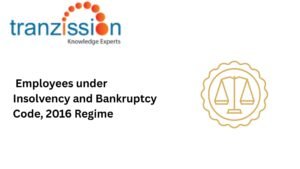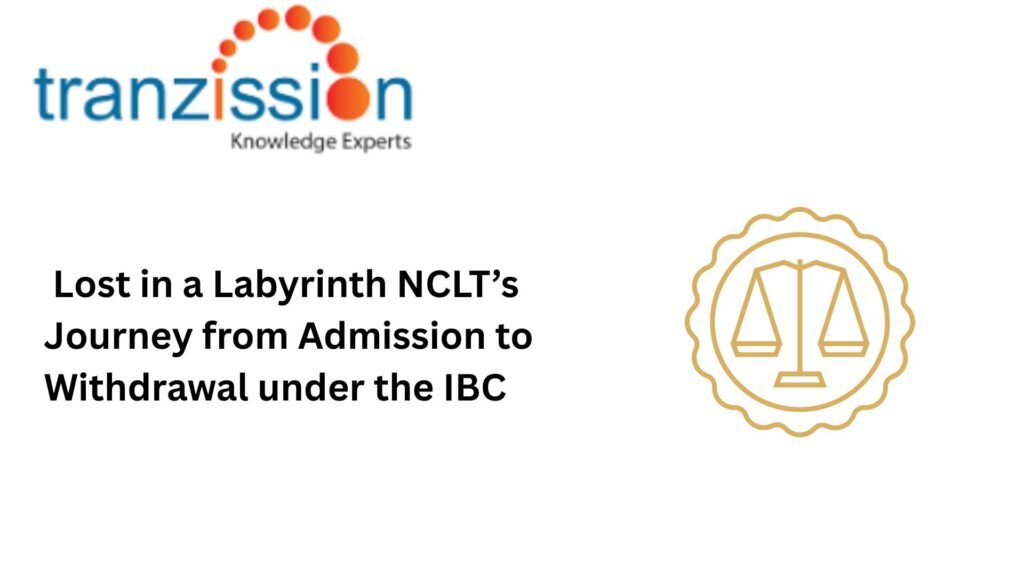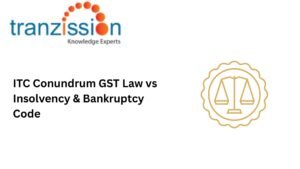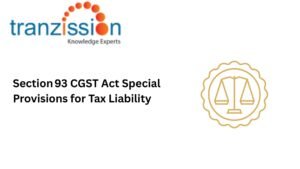
Lost in a Labyrinth NCLT Withdrawal under the IBC

Table of Contents
The insolvency process begins with a creditor or corporate debtor filing an application with the Adjudicating Authority, the National Company Law Tribunal (NCLT), which will then admit the application if it meets the requirements under the Insolvency and Bankruptcy Code, 2016 (“the IBC”). The journey from admission to withdrawal has evolved since the enactment of the IBC. Initially, withdrawal after admission was not explicitly provided for, but now under section 12A of the IBC, the NCLT Withdrawal under the IBC
Historical Context: The Lokhandwala Kataria Dilemma
In 2018, the Supreme Court, in the Lokhandwala Kataria case, addressed the issue of withdrawing corporate insolvency resolution process (CIRP) applications after admission. While Rule 11 of the National Company Law Tribunal Rules, which deals with inherent powers, were not directly applied to the IBC, the court invoked Article 142 of the Constitution of India, to allow withdrawal in specific cases where a large number of creditors had agreed to a settlement. This effectively allowed parties to bypass the usual appellate process and approach the Supreme Courts directly for such withdrawals. In the case of Uttara Foods & Feeds Pvt. Ltd. vs. Mona Pharmachem, the Supreme Court recommended legislative reform to allow the withdrawal of insolvency petitions, even after admission by the NCLT or National Company Law Appellate Tribunal (NCLAT), if parties have reached a settlement. This recommendation stemmed from the court’s observation that current rules prevent the NCLT and NCLAT from exercising their inherent powers to allow such withdrawals, leading to unnecessary appeals before the Supreme Court.
Section 12A & Regulation 30A: Clearing the Path
Section 12A of the IBC, introduced in 2018, allows the NCLT to permit the withdrawal of an insolvency application after it has been admitted, provided the Committee of Creditors (CoC) approves the withdrawal with a 90% voting share. This provision enables genuine settlements and prevents frivolous withdrawals by requiring a high threshold of creditor approval. Regulation 30A of the Insolvency and Bankruptcy Board of India (Insolvency Resolution Process for Corporate Persons) Regulations, 2016 (“CIRP Regulations”) enhances the practicability of withdrawing an insolvency application under section 12A. It allows for withdrawal through the interim resolution professional (IRP) even before the CoC is formed, within 3 days of receipt. After CoC formation, the CoC has 7 days to decide on the withdrawal application.
Pre-CoC Withdrawal: Supreme Court Clarity
In the Swiss Ribbons case, the Supreme Court upheld the NCLT’s inherent power under Rule 11 of the NCLT Rules to allow withdrawal of an application for CIRP even before the CoC is formed. This is because, before the CoC is formed, there is no mechanism for creditors to collectively decide on a withdrawal. The Supreme Court’s legal reasoning centers around the harmonious interpretation of section 12A and Rule 11 of the NCLT Rules in Ashok G. Rajani v. Beacon Trusteeship Ltd. Further, the court in the matter of Abhishek Singh Vs. Huhtamaki Ppl Limited & Anr. has held that this section does not debar admission of applications for withdrawal of CIRP before the constitution of the CoC and that settlements are permissible.
Post-CoC, Pre-EoI Withdrawal
If the application is made after the CoC is formed, the withdrawal requires the approval of 90% of the voting share of the CoC. The application is withdrawn through the IRP or resolution professional (RP) to the NCLT, depending on whether the CoC has been constituted. Such withdrawals are often related to settlement between the parties involved and are distinct from a resolution plan. Regulations related to section 12A, such as Regulation 30A, are considered directory and not mandatory, meaning there can be flexibility in specific cases. The Supreme Court in Abhishek Singh Vs. Huhtamaki Ppl Limited & Anr. confirms Regulation 30A of the CIRP Regulations is binding and CoC timing is essential.
Withdrawal After Inviting Expressions of Interest?
In the Brilliant Alloys case, the Supreme Court clarified that Regulation 30A of the CIRP Regulations concerning the withdrawal of an insolvency application after the expression of interest (EoI) is directory, not mandatory. This decision implies that withdrawals after the EoI stage are possible, especially if the CoC approves, suggesting that exceptional circumstances may warrant such a move. The court emphasised that Regulation 30A should be interpreted in harmony with section 12A of the IBC, which does not specify a deadline for withdrawals.
Withdrawal at Liquidation Stage
In the case of V. Navaneetha Krishnan, the NCLAT observed that an application can be withdrawn under Section 12A even during the liquidation stage if the CoC approves it with 90% of votes. Similarly, in the Vallal RCK, the Appellate Tribunal clarified that a withdrawal of an insolvency application, even after a liquidation order has been passed, is permissible if approved by 90% of the CoC. This decision emphasised that the commercial wisdom of the CoC, when acting with the requisite majority, should generally be respected by the NCLT, unless their decision is deemed arbitrary or irrational read more Insolvency Petition Procedure in India
Unresolved Complexities & Policy Gaps
While the courts generally defer to the commercial wisdom of the CoC in insolvency proceedings, repeated withdrawal of CIRP applications can negatively impact timelines and asset values, The Supreme Court has emphasized that the CoC’s decisions, while respected, are not absolute and can be reviewed for adherence to legal requirements and for reasonableness. Excessive or frivolous withdrawals can disrupt the process and potentially lead to value erosion for all stakeholders, including creditors. Further, while section 12A outlines the process for withdrawal, its application in the context of post-plan scenarios is less clear. The main question that arises is whether a withdrawal can be entertained after a resolution plan has been approved, or if it is limited to the CIRP stage. In addition to this, while the NCLT can intervene in such cases, the specific criteria for intervention and the extent of its review powers are not always defined.
Summary: Withdrawal Maze Simplified
- Pre-admission: Withdrawal is possible through the NCLT through Rule 8 of the Insolvency and Bankruptcy (Application to Adjudicating Authority) Rules, 2016 before the application is admitted.
- After admission, before the constitution of the CoC: Withdrawal can be sought through the NCLT using Rule 11 of the NCLT Rules, section 12A and Regulation 30A of the CIRP Regulations.
- After formation of the CoC, and before EoI: Withdrawal requires approval from 90% of the CoC, followed by submission of the application to the NCLT through the IRP.
- Withdrawal is permitted during liquidation, after EoI only if the CoC resolution and and IRP route are followed.
Implications for Stakeholders
Despite its advantages, there can be adverse impacts on stakeholders:
- Corporate debtors and creditors: Section 12A enables companies to settle their debts and disputes with creditors outside of the formal insolvency process, potentially saving time and costs. Further, it also helps to minimise the burden on the judicial system and avoid lengthy and expensive litigation, while preventing the further depletion of assets.
- Resolution professionals: The timing of withdrawal applications is crucial, particularly around key milestones of the insolvency process, such as the constitution of the CoC. The RP plays a vital role in facilitating the withdrawal process, whether it be before or after the CoC formation. They have the responsibility for presenting the application, coordinating with the CoC, and submitting the application to the NCLT.
- NCLT benches: The NCLT benches are expected to uphold procedural discipline and respect the commercial decisions of the CoC. This involves ensuring fair and transparent processes while recognising the autonomy of the CoC, that the withdrawal application is submitted in the correct manner, and that the required approvals are obtained.
Conclusion : NCLT Withdrawal under the IBC
While section 12A of the IBC and related judicial interpretations provide a framework for withdrawing insolvency proceedings, it is a complex area with potential for misuse. If utilized properly, it can offer a transparent and efficient mechanism for resolving insolvency outside of formal proceedings, but challenges and criticisms exist, particularly regarding the scope of who can initiate withdrawal and the potential for bias against revival.





